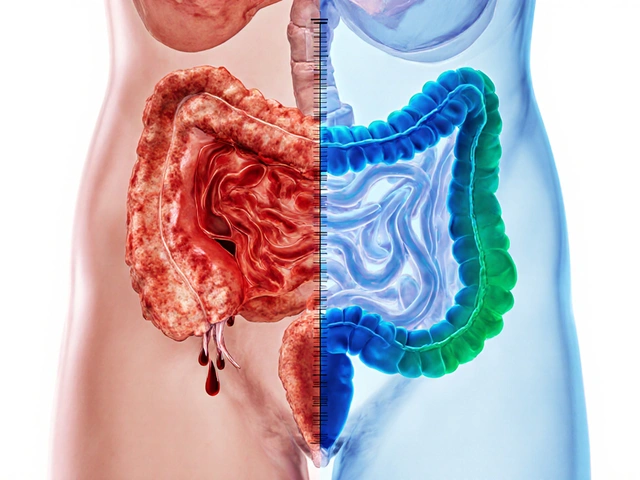
Lupus Stress Management Planner
\n\nStress Management is a set of strategies that aim to reduce psychological and physiological stressors, shown to influence disease activity in autoimmune conditions.
What Are Discoid and Systemic Lupus?
Discoid Lupus Erythematosus (DLE) is a chronic skin‑limited form of lupus that causes red, disc‑shaped lesions, often on the face or scalp. It accounts for about 10‑20% of all lupus cases and rarely progresses to systemic disease.
Systemic Lupus Erythematosus (SLE) is a multisystem autoimmune disease that can affect skin, joints, kidneys, brain and blood vessels. Prevalence varies worldwide, with New Zealand reporting roughly 30 per 100,000 adults.
Both conditions belong to the broader class of Autoimmune Diseases, where the immune system mistakenly attacks healthy tissue.
The Stress‑Immune Connection
When you feel threatened, the brain triggers the Hypothalamic‑Pituitary‑Adrenal (HPA) Axis to release Cortisol, the primary stress hormone. Short bursts of cortisol help regulate inflammation, but chronic elevation desensitises receptors and can lead to a pro‑inflammatory state.
In lupus patients, persistent stress skews cytokine production toward Cytokines such as interleukin‑6 (IL‑6) and tumor necrosis factor‑α (TNF‑α). Elevated levels of these molecules have been linked to skin lesions in DLE and organ involvement in SLE.
Scientific Evidence Linking Stress to Lupus Flares
- A 2022 longitudinal cohort from the University of Auckland found that patients reporting high perceived stress had a 1.8‑fold increase in SLEDAI (Systemic Lupus Erythematosus Disease Activity Index) scores over six months.
- In a 2021 dermatology trial, DLE participants who practiced mindfulness experienced 30% fewer new lesions compared with a control group.
- Meta‑analysis of 15 studies (2020‑2024) concluded that mind‑body interventions reduced flare frequency by an average of 25% across both DLE and SLE populations.
These data underscore that managing stress isn’t just about feeling better-it materially changes disease trajectories.

Top Stress‑Management Techniques for Lupus
| Technique | Core Practice | Typical Session Length | Evidence Strength |
|---|---|---|---|
| Mindfulness‑Based Stress Reduction (MBSR) | Guided meditation and body scan | 8weeks, 2hrs weekly | Strong (multiple RCTs) |
| Cognitive‑Behavioral Therapy (CBT) | Thought restructuring, skills training | 12weeks, 1hr weekly | Moderate (blinded trials) |
| Physical Exercise | Aerobic + resistance activities | 30‑45min, 3‑5times weekly | Emerging (observational data) |
Choosing the right mix depends on personal preference, disease severity, and access to qualified providers. The key is consistency-most benefits appear after 8‑12 weeks of regular practice.
Building a Personal Stress‑Reduction Plan
- Assess baseline stress using a validated tool such as the Perceived Stress Scale (PSS).
- Identify triggers specific to lupus flares-e.g., work overload, lack of sleep, anxiety about medication side‑effects.
- Select at least two techniques from the table above; start with low‑intensity options (e.g., 10‑minute guided breathing).
- Schedule practice sessions in a journal; treat them as non‑negotiable medical appointments.
- Track disease activity weekly (self‑report, skin photos, SLEDAI if you have access to labs) to see correlations.
- Review progress with your rheumatologist or dermatologist every 3 months and adjust the plan.
Patients who adopt this structured approach often report improved mood, better sleep, and fewer steroid bursts.
Practical Tips for Clinicians
- Screen every lupus visit for high perceived stress; a single PSS question takes under a minute.
- Provide written handouts on MBSR and CBT resources available in Auckland and online.
- Collaborate with physiotherapists to design low‑impact exercise regimens that respect joint pain.
- Document stress‑related interventions in the electronic health record; correlate with flare dates for future research.
Related Concepts Worth Exploring
Understanding the broader field of psychoneuroimmunology helps contextualize why stress matters. It studies how thoughts, nerves, and immune cells interact, offering insight into why mindfulness can dampen IL‑6 spikes. Another useful angle is Patient‑Reported Outcome Measures (PROMs), which capture real‑world changes in fatigue, pain, and mood-often the earliest sign of an impending flare.

Frequently Asked Questions
Can stress really trigger a lupus flare?
Yes. Multiple studies show that high perceived stress precedes increases in disease activity scores for both DLE and SLE. Stress hormones like cortisol disrupt normal immune regulation, leading to higher levels of inflammatory cytokines that can ignite skin lesions or organ involvement.
Is mindfulness safe for lupus patients on immunosuppressants?
Mindfulness practices are non‑pharmacologic and have no known interactions with immunosuppressive drugs. In fact, RCTs indicate they can reduce the need for steroid bursts when used consistently.
How much exercise is recommended for someone with joint pain?
Start with low‑impact activities like swimming, cycling, or gentle yoga. Aim for 20‑30 minutes, three times a week, and gradually increase intensity as tolerated. A physiotherapist can tailor a program that protects joints while boosting cardiovascular health.
Do I need a therapist for CBT, or can I use apps?
Both options work. Certified CBT therapists provide personalized feedback and can address lupus‑specific concerns. Evidence‑based apps (e.g., MoodGym, Pacifica) offer guided modules that have shown moderate efficacy in reducing stress scores.
How quickly can I expect to see improvements after starting stress‑management?
Most participants notice mood and sleep improvements within 2‑4 weeks. Objective reductions in flare frequency typically emerge after 8‑12 weeks of consistent practice.




14 Comments
Just breathe. It helps.
Of course stress causes flares - it’s obvious. But why are we letting these fancy Western wellness trends replace real medicine? In America, we don’t need meditation to fix what pharmaceuticals already solve. This is just another scam to sell yoga mats and overpriced apps.
I’ve seen lupus patients on steroids who didn’t care about mindfulness - they cared about not dying. Stop gaslighting people into thinking their pain is all in their head because they didn’t meditate enough.
I get it. I really do. I’ve been there - 3 a.m. panic attacks, skin lesions burning like fire, and my boss asking why I’m ‘so tired’ again. I didn’t have money for CBT, so I used YouTube guided meditations on my phone while lying on the bathroom floor. It didn’t fix everything… but it kept me from crying myself to sleep every night.
It’s not about replacing medicine. It’s about surviving the in-between. The days when the pills aren’t enough and the world keeps spinning like nothing’s wrong.
Thank you for writing this. I needed to see someone say it out loud.
The HPA axis dysregulation in lupus isn’t just a physiological anomaly - it’s a systemic betrayal of homeostasis where the very mechanism meant to restore balance becomes the architect of its own collapse
Chronic cortisol elevation doesn’t merely suppress immunity - it rewires neuroendocrine feedback loops to favor proinflammatory cytokine dominance, effectively turning the body’s natural defense into a self-sabotaging feedback loop
This is why mindfulness isn’t a luxury - it’s a biological intervention that resets autonomic tone, reduces sympathetic overdrive, and downregulates IL-6 transcription via vagal activation
The meta-analysis showing 25% reduction in flares isn’t anecdotal - it’s epigenetic. Stress modulation alters gene expression in immune cells, not just perception
CBT works because it interrupts catastrophic thinking patterns that activate the amygdala, which then signals the hypothalamus to perpetuate the stress cascade
Exercise isn’t just about endorphins - it’s about myokine release from muscle tissue that acts as a natural anti-inflammatory signal to macrophages
The real tragedy isn’t the disease - it’s that we still treat autoimmune conditions as if they’re purely immunological, ignoring the neuro-immune dialogue that’s been documented since the 1980s
We need to stop framing this as ‘alternative’ and start recognizing it as foundational pathophysiology
Someone should write a textbook on psychoneuroimmunology for rheumatologists - because right now, most of them still think stress is just ‘emotional’
And yes - the PSS is crude but valid. It correlates with CRP and IL-6 levels in prospective studies. Don’t dismiss it because it’s subjective - all pain is subjective until you measure it
Consistency matters more than intensity. Ten minutes daily beats two hours once a week. Neuroplasticity doesn’t care about your schedule - it cares about repetition
This isn’t wellness theater. It’s medicine with a different delivery system.
While the article presents a compelling narrative, it lacks rigorous methodological critique of the cited studies. The 2022 Auckland cohort, for instance, relied on self-reported stress metrics without controlling for confounders such as socioeconomic status, sleep quality, or concurrent infections - all known drivers of lupus activity. Furthermore, the mindfulness trial’s control group was not adequately blinded, rendering the 30% lesion reduction statistically suspect. The meta-analysis combines heterogeneous interventions under the umbrella of ‘mind-body’ without stratifying by disease subtype, potentially obscuring null effects in SLE versus DLE. Without addressing these limitations, the recommendation to treat stress management as a clinical standard appears premature and potentially misleading.
Thank you for sharing this with such clarity. I’ve been managing SLE for 12 years, and I wish I’d known this 10 years ago.
I started with 5 minutes of breathing before bed - just noticing the air coming in and out. No apps, no bells, no pressure. After six weeks, I slept through the night for the first time in years.
Then I added walking - not to burn calories, but to feel my feet on the ground. My joints still ache, but the constant dread? It’s quieter now.
You don’t need to do all of it. You just need to do one thing, consistently. Even if it’s just sitting in the sun for ten minutes without checking your phone.
And if someone tells you it’s ‘just in your head’ - tell them your immune system disagrees.
If you’re stressing about your lupus, you’re doing it wrong. Just take your meds and stop being dramatic. This article is just woke medicine nonsense.
As someone from India where mental health is still taboo, I’m grateful this exists. My sister has DLE - she hid it for years because people said ‘you look fine.’ When she tried yoga, she cried the first time - not from pain, but because someone finally said her pain mattered.
Stress isn’t weakness. It’s the body screaming to be heard.
I used to think stress management was for people who had time to sit around and ‘find themselves.’ Then I got diagnosed with SLE at 29 and realized - I didn’t have time. But I had to find a way to survive.
I started journaling. Not ‘Dear Diary’ stuff. Just three lines: What hurt today? What felt okay? What tiny thing gave me a second of peace?
One day I wrote: ‘The cat curled on my lap. Her purr felt like a lullaby for my broken body.’
That’s when I knew - healing isn’t about fixing everything. It’s about finding moments where you’re not fighting yourself.
Some days, that’s enough.
Interesting… I mean, *interesting*… 🤔
But have you considered that maybe the correlation isn’t causation? Maybe people who flare more *become* stressed because their lives are a mess, not the other way around? Also, mindfulness is just capitalism repackaging Buddhist monks as corporate wellness consultants. 🤷♂️
Also, ‘PSS’? That’s not even a real scale. It’s like asking someone if they feel ‘kinda bad’ and calling it science.
Let’s be real - this whole article is just a glorified lifestyle blog disguised as medical advice. The ‘25% reduction’ claim? That’s from studies with tiny samples and no placebo controls. And mindfulness? I’ve seen patients who meditated daily and still ended up on dialysis. Coincidence? Or just bad science?
Real treatment is immunosuppressants. Not breathing exercises. Stop infantilizing patients with chronic illness.
I’m from the U.S. but lived in Japan for five years. There, they don’t call it ‘stress management’ - they call it ‘living with your body.’ No hype. No apps. Just quiet acceptance.
My aunt had lupus. She didn’t meditate or journal. She made tea every morning. Sat by the window. Watched the rain. Didn’t fight the pain. Didn’t glorify it. Just… let it be.
She lived longer than anyone expected. Not because she ‘beat’ her disease - but because she stopped warring with herself.
Maybe the real breakthrough isn’t in the technique… but in the permission to rest without guilt.
i just wanted to say thank you for this. i’ve been living with dle for 7 years and no one ever talks about how exhausting it is to explain to people why you can’t just ‘get over it’ or ‘stop being so stressed’
i started doing 10 min breathing before bed and it’s not magic but it’s… something. i don’t feel so alone anymore
ps: i think you meant ‘orthography’ but i’m not sure if you spelled it right lol
Correction: You’re right about the spelling - I meant ‘orthography’ as in written form, not ‘orthopedics.’ Thank you for catching that. The fact that you noticed - and felt safe enough to point it out - is itself a small act of healing. That’s the kind of community this article should inspire: not perfection, but presence.